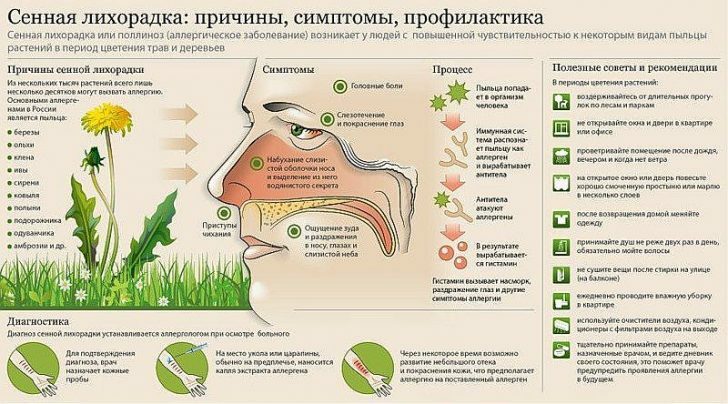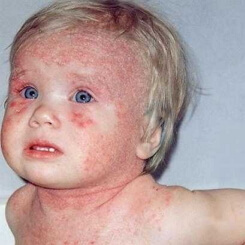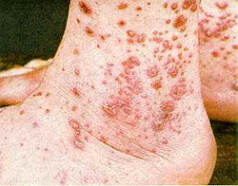Allergic conjunctivitis: symptoms and treatment
 The term "allergic conjunctivitis" means inflammation of the mucous membrane of the eye, which is of an allergic nature, i.e. developing due to an inadequate response of the immune system.A conjunctiva is a thin transparent shell lining the inner part of the eyelids and covering the sclera of the eyeballs.Pathology is also called "red eye disease", because swollen and reddened eyelids are one of the characteristic clinical manifestations.
The term "allergic conjunctivitis" means inflammation of the mucous membrane of the eye, which is of an allergic nature, i.e. developing due to an inadequate response of the immune system.A conjunctiva is a thin transparent shell lining the inner part of the eyelids and covering the sclera of the eyeballs.Pathology is also called "red eye disease", because swollen and reddened eyelids are one of the characteristic clinical manifestations.
According to medical statistics, about 15% of the population is affected by allergic conjunctivitis.In some countries with poor environmental conditions, allergic symptoms are occasionally observed in 40% of people.Pathologies are more susceptible to young patients.
Contents: Types of disease Causes of allergic conjunctivitis symptoms of allergic conjunctivitis Complications Diagnosis Allergic conjunctivitis in children Treatment of allergic conjunctivitiskinds of diseases
Accepted provide:
-
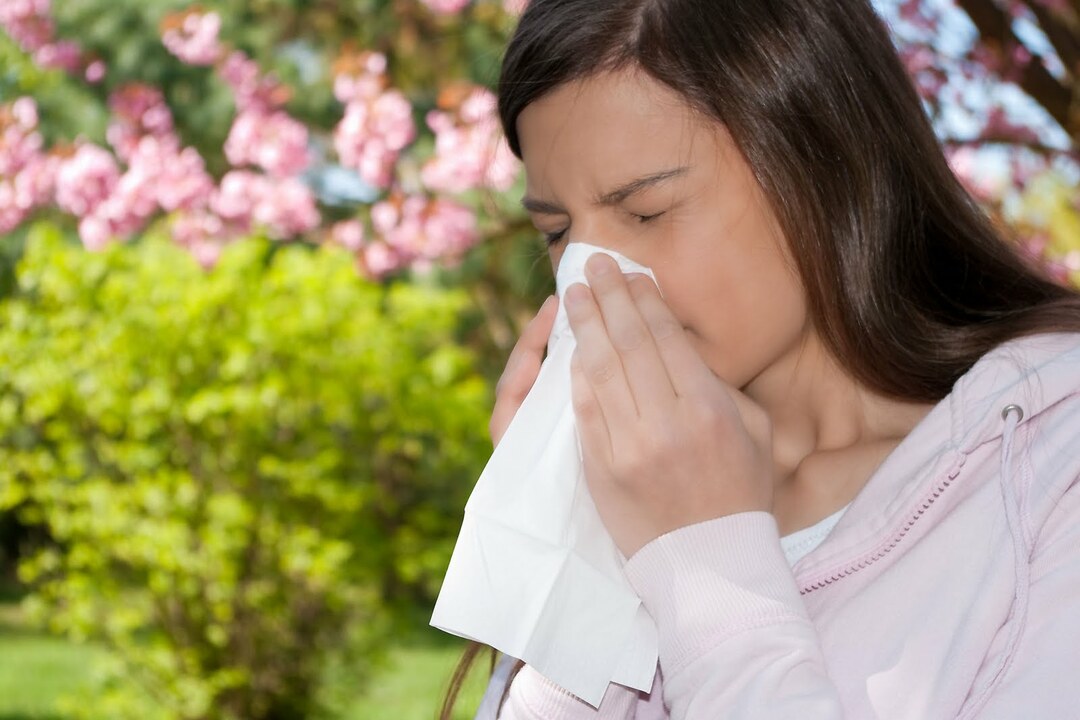 seasonal allergic conjunctivitis( hay fever, hay fever);
seasonal allergic conjunctivitis( hay fever, hay fever); - year-round allergic conjunctivitis;
- conjunctivitis with papillary hyperplasia;
- spring keratoconjunctivitis;
- atopic keratoconjunctivitis( a form more characteristic for adult patients).
Seasonal allergic conjunctivitis( hay fever or flower fever) develops when responding to pollen.Symptomatics is manifested every year, strictly in the same months.
All-year-round allergic conjunctivitis occurs within a few hours or even days after exposure to certain types of household chemicals, hygiene products or cosmetics.
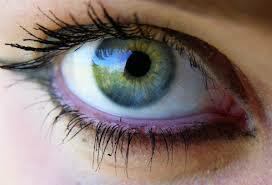 The reason for the development of conjunctivitis with hyperplasia of the papillae is most often the continuous continuous wearing of soft contact lenses.Protein compounds, present in normal eye discharge, accumulate on the inner surface of these optical devices and change their structure.If a person has a tendency to allergies, they provoke a local immunological reaction with the formation of papillae on the inner surface of the eyelids.
The reason for the development of conjunctivitis with hyperplasia of the papillae is most often the continuous continuous wearing of soft contact lenses.Protein compounds, present in normal eye discharge, accumulate on the inner surface of these optical devices and change their structure.If a person has a tendency to allergies, they provoke a local immunological reaction with the formation of papillae on the inner surface of the eyelids.
 Spring keratoconjunctivitis( spring catarrh) is more common in childhood and extremely rare in people older than 20-25 years.The incidence among boys is 2 times higher than among their peers.Symptomatic develops annually in warm weather;The total duration of the disease is from 4 to 10 years.On the inner part of the century, giant papillae form.This type of allergic conjunctivitis in children is dangerous because the pathological process can affect the cornea.
Spring keratoconjunctivitis( spring catarrh) is more common in childhood and extremely rare in people older than 20-25 years.The incidence among boys is 2 times higher than among their peers.Symptomatic develops annually in warm weather;The total duration of the disease is from 4 to 10 years.On the inner part of the century, giant papillae form.This type of allergic conjunctivitis in children is dangerous because the pathological process can affect the cornea.

Atopic keratoconjunctivitis is characterized by a chronic course and presents a particular danger due to the high probability of complications - blepharitis, corneal ulcers and retinal detachment.For this form, the disease is characterized by a parallel development of allergic rhinitis.

Causes of development of allergic conjunctivitis
The disease develops as a result of immediate and delayed hypersensitivity reactions from the immune system.The immediate cause is contact with a certain allergen.
Possible allergens:
- wool and skin particles( epidermis) of animals;
- active and auxiliary components of medicinal products;
- detergent components;
- pollen of plants( typical of hay fever);
- cosmetic products;
- dust;
- dry food for aquarium fish.
Important: allergic conjunctivitis in some cases develops as a reaction to the wearing of contact lenses.
The causes of the disease are often such factors as light and ionizing radiation( radiation), as well as infectious agents of a viral or bacterial nature.
The course of the disease can be both prolonged chronic( sluggish) and acute( it develops rapidly and quickly passes through the termination of contact with the allergen).
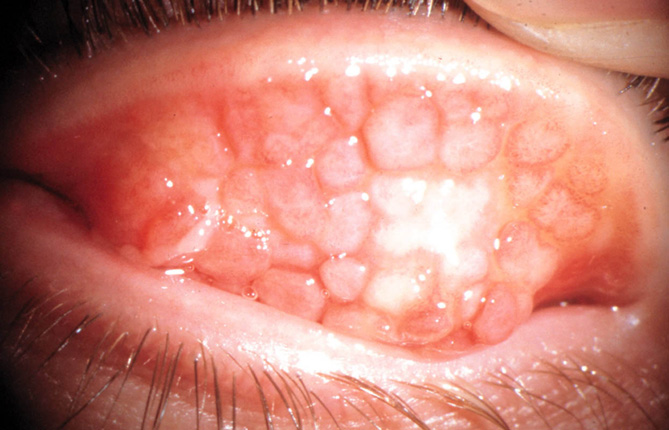
As a result of the progression of the pathological process, the proliferation of connective tissue is often noted.As a consequence, fibrosis and an increase( hypertrophy) of the conjunctival papillae are possible.
Note: inflammation of the conjunctiva is very often combined with allergic rhinitis and atopic dermatitis.An increased predisposition to such eye damage is noted in patients suffering from bronchial asthma.
Allergic reactions of the cornea develop when the body reacts to topical preparations, as well as to toxins that are capable of producing certain types of bacteria( in particular, staphylococci and pale treponema).
Symptoms of allergic conjunctivitis
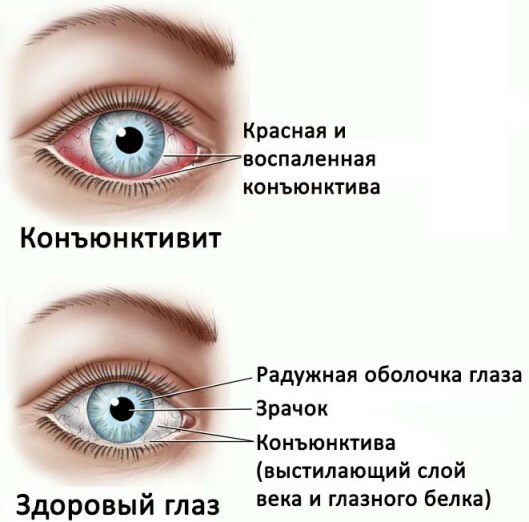
In pathology, as a rule, the lesion is symmetrical, that is, both eyes are affected.Unilateral defeat is not excluded, but it is extremely rare.
 The following clinical manifestations are typical for all forms of the disease:
The following clinical manifestations are typical for all forms of the disease:
- hyperemia of the eyelids;
- puffiness of the eyelids;
- itching( burning or burning) in the eyes;
- lacrimation;
- photophobia.
Note: pruritus is the main manifestation;He forces the patient to constantly rub his eyes, which only increases the severity of other symptoms.
Often, such parallel developing allergic symptoms as frequent sneezing, coughing and runny nose are noted.
Complications of
As a consequence of the atopic form of the disease, corneal ulcers can develop that develop against the background of a viral( eg, herpetic) or bacterial infection.There is a rather high probability of such serious complications as
bacterial inflammation of the eyelids( blepharitis), as well as development of clouding of the lens of the eye( cataracts) and retinal detachment.As a result, partial or complete loss of vision is possible.
Diagnosis
Recommended to read: 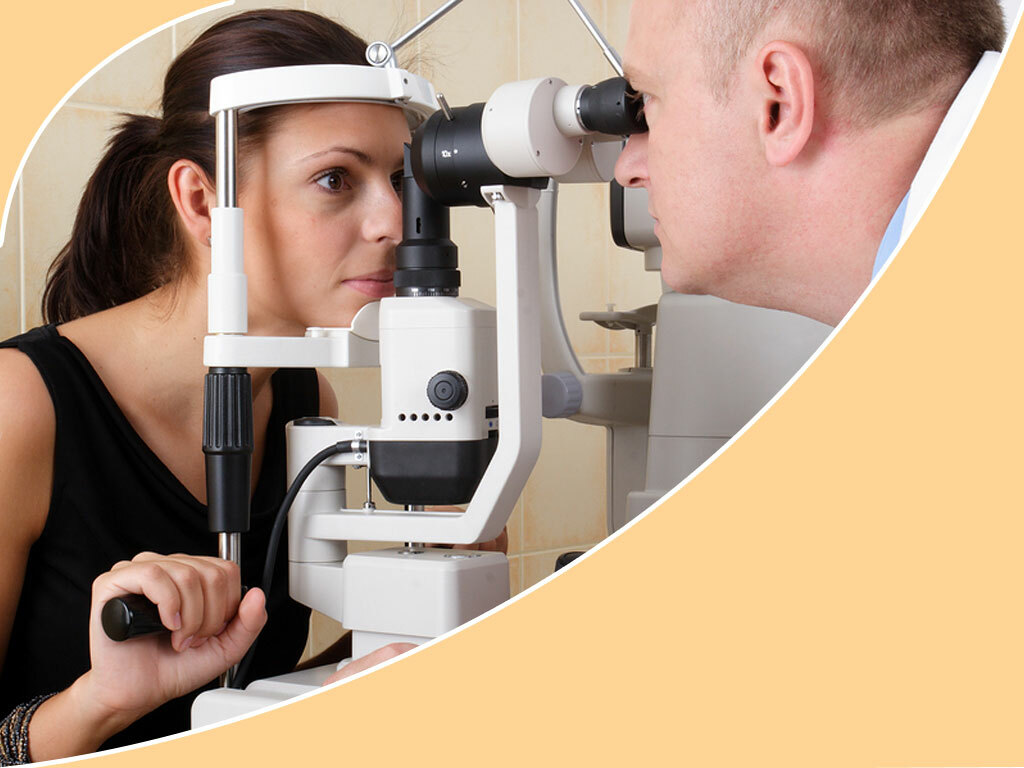 The diagnosis of "allergic conjunctivitis" is made by an ophthalmologist.In most cases, an additional consultation with an allergist is required.
The diagnosis of "allergic conjunctivitis" is made by an ophthalmologist.In most cases, an additional consultation with an allergist is required.
The data are based on the history and external examination data.To clarify the nosological form and identify the allergen requires a number of additional studies, including the setting of skin( scarification) samples.
Allergic conjunctivitis in children
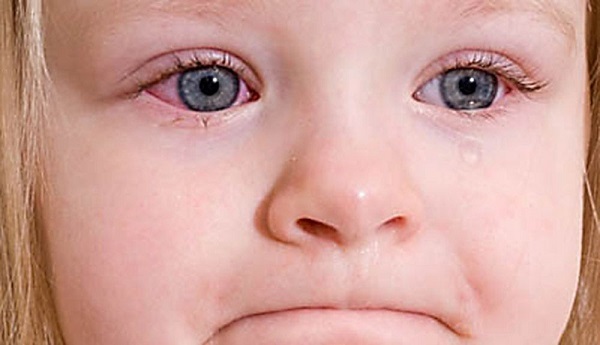 Allergic conjunctivitis in infants is very rarely diagnosed.In most cases, this disease develops in a child over 3 years old.The probability of occurrence of this pathology is higher in small patients with allergic reactions in the anamnesis( diathesis, dermatitis).
Allergic conjunctivitis in infants is very rarely diagnosed.In most cases, this disease develops in a child over 3 years old.The probability of occurrence of this pathology is higher in small patients with allergic reactions in the anamnesis( diathesis, dermatitis).
When identifying a possible allergen and diagnosing it is necessary to take into account some features.In childhood, the reaction of hypersensitivity to various foods is very common.In addition, the child can develop so-called.Pseudoallergic reaction due to diseases of the gastrointestinal tract or helminthiases.
Treatment of allergic conjunctivitis
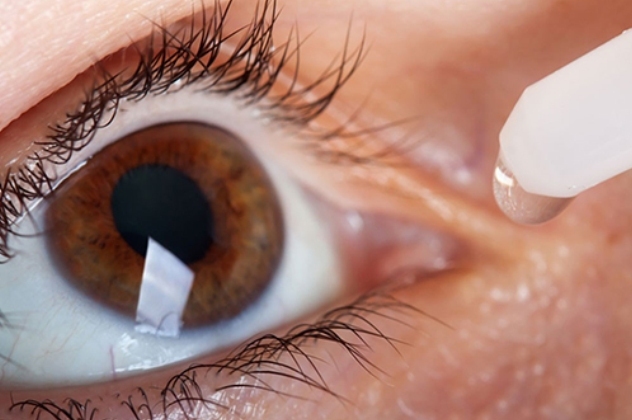 A prerequisite for the successful therapy of allergic conjunctivitis is the complete cessation of contact with a factor that is an allergen or its elimination.With a mild course of the disease, it is enough to apply cold compresses to the eyelids and instill drugs similar in composition to the tear fluid.Pathogenetic and symptomatic therapy involves the use of anti-inflammatory and anti-allergic( antihistamines) funds.
A prerequisite for the successful therapy of allergic conjunctivitis is the complete cessation of contact with a factor that is an allergen or its elimination.With a mild course of the disease, it is enough to apply cold compresses to the eyelids and instill drugs similar in composition to the tear fluid.Pathogenetic and symptomatic therapy involves the use of anti-inflammatory and anti-allergic( antihistamines) funds.
For the treatment of allergic conjunctivitis caused by reaction to pollen of plants, drugs narrowing small blood vessels are used, as well as drugs that reduce the release of histamine and other mediators of allergy and inflammation.LS are appointed locally, and with pronounced allergic symptoms - orally( Loratadin, Cetirizine).In some cases, the appointment of hormonal drugs( glucocorticosteroids).
 In case of allergic conjunctivitis, which has developed due to the use of cosmetics or other substances, it is necessary to exclude contact with the allergen, and on the eyelids several times a day to do cold lotions.If the symptoms do not disappear, then you need to contact a specialist who prescribes medication.
In case of allergic conjunctivitis, which has developed due to the use of cosmetics or other substances, it is necessary to exclude contact with the allergen, and on the eyelids several times a day to do cold lotions.If the symptoms do not disappear, then you need to contact a specialist who prescribes medication.
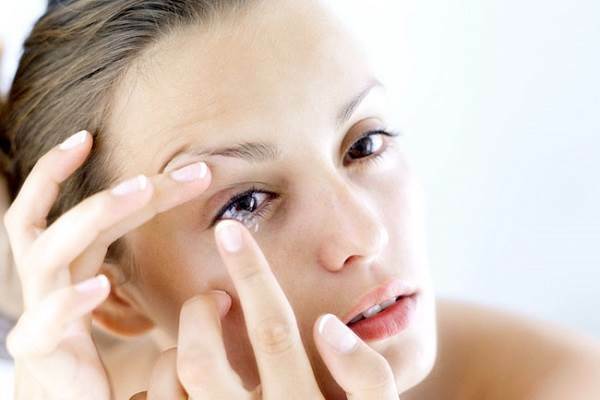 When conjunctivitis with hyperplasia of the papillae it is advisable to temporarily abandon the lens or shorten the time of wearing them.It is also recommended to replace them with models from another polymer.Devices should be washed as often as possible to prevent the accumulation of eye secretions.Reduce the severity of the symptoms allow for some types of eye drops.If the doctor has established that numerous and fairly large papillae have already formed, then lenses should be discarded altogether.The use of vasoconstrictors and antihistamines may be indicated.
When conjunctivitis with hyperplasia of the papillae it is advisable to temporarily abandon the lens or shorten the time of wearing them.It is also recommended to replace them with models from another polymer.Devices should be washed as often as possible to prevent the accumulation of eye secretions.Reduce the severity of the symptoms allow for some types of eye drops.If the doctor has established that numerous and fairly large papillae have already formed, then lenses should be discarded altogether.The use of vasoconstrictors and antihistamines may be indicated.
Symptoms of spring keratoconjunctivitis weaken with prolonged exposure to cold.Specific therapy methods have not been developed;The recommended remedies help to cure the acute symptoms of inflammation.A positive effect is achieved by hormonal( steroid) drugs( mometasone furoate and fluticasone propionate), but the disease lasts a long time, which excludes their constant use to avoid the development of serious side effects.The way out can be hormonal therapy, carried out at certain time intervals.
Good effect in the treatment of allergic conjunctivitis allows to achieve the use of H1-topical antihistamines( Allergodyl, Analergin).Children under the age of 12 years are shown drops of Levocabastine.Preparations of this group can very quickly eliminate the symptoms of inflammation, but they often have to be used( up to 4 times a day), since they are characterized by a short period of action.
Many patients are shown drops-vasoconstrictors( vasoconstrictors).
Please note: preparations Vizin, Sanorin, Octylium and Nafazoline can not be used for a long time, as drug addiction develops rapidly and other side effects( including drug conjunctivitis) are not ruled out.
This symptom, like sensation of itching, can be suppressed by the parallel application of H1-blockers and vasoconstrictors.
In case of seasonal allergies, it is advisable to start using the remedies of a group of fat cell membrane stabilizers in advance( Ketotifen, KromoGexal, Lecrolin).They inhibit the allergy mediators.
If the patient wears contact lenses, then 15 minutes before their installation, it is advisable to drip into Zaditen's eyes.The drug is indicated for patients older than 12 years.
With seasonal conjunctivitis of allergic nature, a doctor may prescribe NSAIDs( Ketorolac, Diclofenac) as an alternative to hormonal drugs.Non-steroidal agents have no side effects associated with glucocorticoids.According to clinical studies, such symptoms as photophobia and puffiness they do not remove, but help cope with a feeling of itching.
Corticosteroid ophthalmic ointments( Prenacid, Dexamethasone, Maxiex) are indicated for the treatment of a disease accompanied by papillary hyperplasia and the treatment of atopic keratonic conjunctivitis.
Severe form of allergic conjunctivitis in some cases requires long-term therapy with immunosuppressants( Ciclosporin).
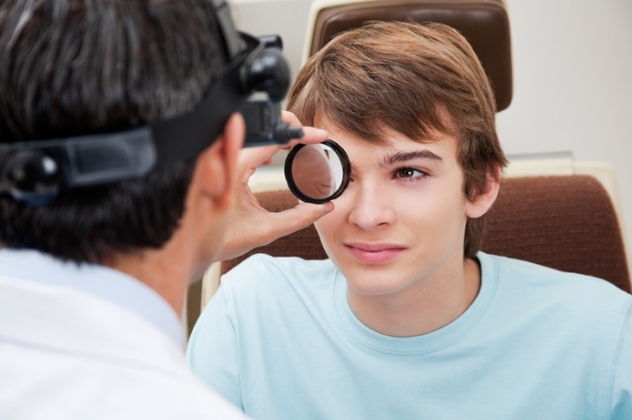 Important: allergic conjunctivitis refers to diseases in which traditional medicine is powerless.Various lotions, washing eyes with herbal decoctions and other "grandmother's methods" will not help to remove symptoms and, even more so, affect the cause.The only thing that can be achieved with such self-medication is to provoke an exacerbation and cause infectious complications.
Important: allergic conjunctivitis refers to diseases in which traditional medicine is powerless.Various lotions, washing eyes with herbal decoctions and other "grandmother's methods" will not help to remove symptoms and, even more so, affect the cause.The only thing that can be achieved with such self-medication is to provoke an exacerbation and cause infectious complications.
More detailed information on the causes of development, types and methods of treatment of allergic conjunctivitis you will get by viewing this video review:
Plisov Vladimir, medical reviewer, phyto-therapeutist

